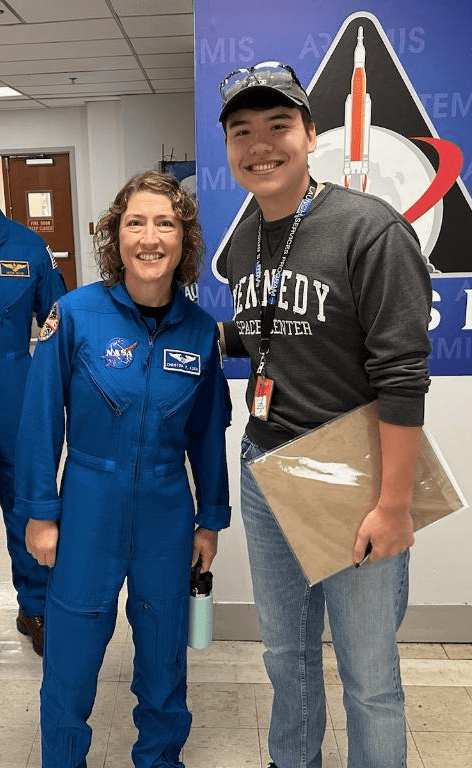

Exploring Space Sustainability with a NASA Internship

It’s a dream for any Aerospace Engineering student to have a chance to work with NASA. This past summer, Connor Arnold (’25) was lucky enough to have that dream come true. Up against thousands of other students from across the country, Connor was one of 50 selected to intern with NASA at the Kennedy Space Center in Florida.
Resource Recovery
For 10 weeks, Connor worked on resource recovery and recycling technology development for human space exploration for NASA.
“I had four different projects, which all centered around recovery of resources and then putting that towards closing the loop in spaceflight habitation,” he explained.
These projects included analyzing wattage and amperage of composters for use on spacecraft, analyzing off-gassing using gas and plasma chromatography, analyzing materials from composters and a tube furnace for nutrient content and researching and testing replacements for transit materials used on the International Space Station (ISS) to reduce environmental impact—plus a few details he can’t talk about.
Exploring NASA

NASA astronaut Christina Koch with Connor Arnold on the NASA site. (Photo: Connor Arnold)
One of his favorite parts of interning at NASA? Meeting astronauts on the job. Connor and other interns were lucky enough to catch up with the Artemis II crew members after they visited the Neil Armstrong Operations and Checkout Building to see the Orion spacecraft, in which they will orbit the moon in 2024.
“They were leaving the clean room for the Orion capsule, and I got to talk with Christina Koch and Victor Glover,” he said. “We went out to the launchpad where they launched the shuttle missions and Apollo missions. . . We got to go see some Blue Origin launching facilities, meet some of the SpaceX crew . . . Yes, we were there to perform a job and to fulfill our internship, but our mentors were also focused on getting us out and doing stuff while we had access to the NASA site.”
Other activities included viewing other interns’ projects on the site, visiting the cryo lab and dipping objects in liquid hydrogen and liquid oxygen, seeing plant research and visiting the Vehicle Assembly Building (VAB), where engineers are preparing to build the next Artemis rocket.
Breaking NASA Property
Connor shared a story of an instance where he and other interns accidentally broke something while conducting an experiment.
“In the middle of one of the experiments, we were performing combustion process within the tube furnace and the material we had in there was dried, so in one second, it jumped from 22 PSI to 50 PSI and cracked our defender,” he said. “And of course, we had a mentor in the lab with us, but it was me and two other interns who were running the tube furnace, and that was kind of an important part because it was a regulator for the system.”
Fortunately, the interns were not reprimanded and the incident was a learning moment for the research team to change the procedure in future experimentation.
Broadening Perspectives
As an Aerospace Engineering major, sustainability and chemistry weren’t necessarily on Connor’s radar, the latter being far from his favorite subject. However, his experiences this summer have changed his outlook.
“I worked in the applied chemistry lab in the Neil Armstrong building at Kennedy Space Center and before I went there, I hated chemistry. I didn't want anything to do with chemistry,” he said. “But after serving my time this summer there and learning about all these projects and plasma fission and building these bioreactors, it really did broaden the spectrum of things that I thought I'd maybe be interested in doing.”
His internship mentors and other researchers he worked with in the lab motivated him to consider pursuing a Ph.D. in addition to the master’s degree he is already planning to get after finishing his bachelor’s.
An important thing Connor learned in his internship experience is that no matter how much training or instruction you get, there’s the inevitability of things breaking or going wrong.
“It’s never going to be perfect,” he said. “But I think that’s what research is. You don’t go into a research program, go straight through, get your results and you’re done. . . there is no perfect solution when it comes to research or engineering.”
He reflected this lesson to his personal experience with perfectionism, stating that the internship changed his perspective on how he sees grades.
“It changed my perspective on what it means to be perfect,” Connor said. “So rather than striving for perfection, I think I’ve learned to just strive for what I know to be my best work.”
Advice for His Peers
Connor’s biggest piece of advice for students seeking out internships is to get involved in research. His mentor told him that research experience even played a bigger part in the selection process than GPA.
He also urges others to just keep applying to internships. He says, “You’re never going to get the first one you apply for. I probably applied for 200 internships for this past summer, and I only heard back from, like, four. . . It’s super competitive.”
Read more about Connor’s ERAU experience here.

